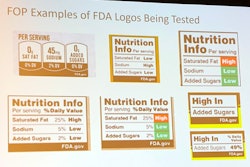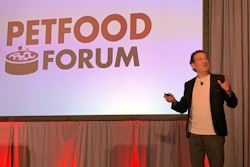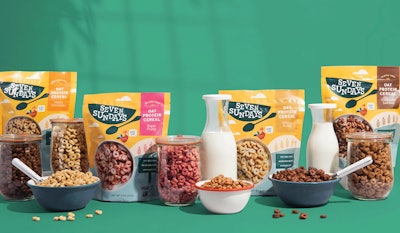
Sure, “upcycling” is one of the latest buzzwords in the food and beverage industry. But it’s also a growing movement that is finding itself increasingly popular as the world—not least of all the manufacturing world—figures out how to curb the copious amounts of food waste that ends up in landfills.
Worldwide, about $1 trillion of food is wasted each year, and more than a third of that food waste happens before the food reaches the consumer—whether on the farm or during the manufacturing process. “Food waste is also the No. 1 contributor to landfills in the U.S., and the disposal of food waste and organic material to landfills is one of the leading causes of global methane emissions, which is the second highest contributor to global warming after carbon dioxide,” says Magenna Brink, membership manager for the Upcycled Food Association (UFA).
There is much that can be done by the manufacturing community to address food waste at the source, optimizing systems and processes so that less is lost along the way. But the upcycling movement has grown largely out of natural byproducts of food and beverage processes—finding ways to take what had previously been considered byproduct waste and make use of it as an ingredient in other foods.
There are strong environmental arguments to be made, of course, for upcycling. Project Drawdown maintains that preventing food waste is the single most effective solution to reducing global warming. You’re not only saving the food itself from the landfill but reducing CO2 emissions—food waste accounts for about 8% of global emission. “When food is wasted, all the energy, resources, and money that went into producing, processing, packaging, and transporting it are wasted, too,” Project Drawdown notes. “Producing uneaten food squanders a whole host of resources—seeds, water, energy, land, fertilizer, hours of labor, financial capital—and generates greenhouse gases at every stage.”
But there’s also a considerable economic argument to be made. Through upcycling, food and beverage companies are turning what used to be waste into revenue streams. Instead of paying somebody to haul away whey, spent grains, subpar produce, and other waste, you could be getting paid for those ingredients to be in somebody else’s products.
A matter of perspective
Your perspective on upcycling might differ considerably depending on what sector of the industry you’re coming from. If you make apple juice, for example, you might be asking, “What’s this ‘upcycling’ you’re talking about? We’ve always used as much of the apple as possible.”
 | Learn how Loop Mission is using high pressure processing to help rescue fruits and vegetables otherwise destined for landfills. |
From the point of view of Jon Kingston, food and beverage industry manager for Flottweg, upcycling is nothing more than the product reclamation that the juice industry has always practiced. The first time the fruit goes through the system, they get non-concentrated juice. The second process adds water back to the remaining pomace, which still has quite a bit of sugar in it, and that goes to juice concentrate. Only dry cake pomace, stripped of its sugar, is then sent off for animal feed, he says.
For some products, upcycling might not make sense as the primary goal. At Bob’s Red Mill, for example, where a lot of their products are closer to their original ingredients—grains, oats, beans, etc.—the end game is focused much more on reduced food waste, though upcycling still plays its part.
“For the big picture, of course, we want to be as close to zero waste as possible. So prevention is a big focus of that,” says Julia Person, sustainability manager for Bob’s Red Mill. “If it can’t be prevented, then we want it to go to its highest and best use. So that’s where upcycling comes in.”
Down on the farm
Inevitably, though, not everything makes it into a packaged, saleable product at Bob’s Red Mill—whether there are packaging issues, or even just milling byproduct that goes into a large dust collection system, notes Kyle Geber, QA material handler for Bob’s Red Mill, where he also focuses on outgoing large format recycling. “Everything that gets sucked up out of the machines ends up going to our feed,” he says. “If there’s damage, anything that would otherwise go to the trash, when it comes to food product that doesn’t end up in a package, we send it off to a farm.”
EnviroFeeds is a national company that works with food manufacturers to keep food waste out of the landfill and turn it into high-quality cattle feed for local farms. In the case of Bob’s Red Mill, based in Milwaukie, Ore., workers from an Oregon dairy farm come pick up a full trailer of byproduct two or three times a week, Geber says, saving 50 to 60 tons of waste a week from the landfill.
“For them, it’s highly nutritious feed,” Person notes. Geber adds, “They’re really satisfied with us because we deal with so many different products, so they get a really complex nutrition profile for their cows.”
Upcycling is not particularly new to brewers and distillers, who have been passing their spent grains—full of proteins and nutrients—along to local farmers as animal feed. Decanter technology has been important here to dewater the grain as much as possible to decrease the volume and lower the cost of transport.
Fit for human consumption
But several food companies are moving that spent grain beyond the animal feed level and into what UFA considers its higher purpose, ingredients for human consumption.
EverGrain, for example, focuses on transforming barley used in the brewing process into high-quality, nutritious, and sustainable protein ingredients for use in other food and beverage products. “We started our journey in 2013, long before upcycling was a trend, with the goal of unlocking every grain of potential in our barley to have a positive impact on people and the planet,” said Gregory Belt, EverGrain CEO, in a press release related to the company’s new large-scale plant-based protein facility in St. Louis.
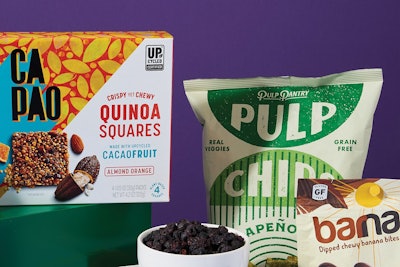 The Upcycled Certified mark can be found now on more than 480 products and ingredients.Upcycled Food Association
The Upcycled Certified mark can be found now on more than 480 products and ingredients.Upcycled Food Association
SunOpta, one of the largest producers of plant-based foods and beverages, was also an early adopter of upcycling and was involved in the early days of UFA’s development. “Upcycling has just become a lot more of an issue and a challenge that manufacturers are trying to tackle,” says Lauren McNamara, vice president and assistant general manager for SunOpta.
Some products might lend themselves more to upcycling, but other products are not as easily transformed. “With soy, we had to figure out how to take those waste products, how to capture them in a food-safe way, then how to transport them and how to dry them, and package them in a way that can be resold or reused,” McNamara says. “The waste product would be a lot easier to get rid of, frankly, than preserving the waste and transforming it into something usable.”
Though SunOpta has been upcycling soy pulp for many years, the company also more recently figured out how to upcycle its oat milk byproduct into a nutrient-rich oat protein powder it calls OatGold, which was Upcycled Certified early last year. Until then, the oat milk byproduct was being land applied by farmers onto their fields.
 | Watch a short video about the innovation that earned SunOpta a Manufacturing Innovation Award from ProFood World. |
The process of making oat milk begins with whole rolled oats, which get cooked with enzymes and water. The solubles go in one direction and the insolubles get filtered out so that the final milk product is smooth and creamy. “The stuff that gets filtered out is actually quite nutritious. It has a more concentrated protein, it has more fiber in it,” McNamara says. “So we started collecting this OatGold, as we now call it, in the plant and we started playing around with it internally with our R&D teams.”
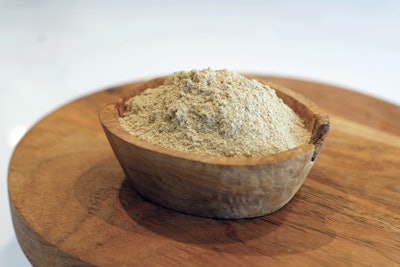 Upcycled from the oat milk byproduct, SunOpta’s OatGold has a higher concentration of protein and fiber than the original oats that went into it.SunOpta
Upcycled from the oat milk byproduct, SunOpta’s OatGold has a higher concentration of protein and fiber than the original oats that went into it.SunOpta
They used the OatGold to make muffins, pancakes, cookies, even soap, McNamara says. And in June this year, SunOpta announced a partnership with Seven Sundays, which prides itself as a planet-forward breakfast company that uses biodiverse, natural ingredients. Seven Sundays has launched an oat protein cereal made with SunOpta’s OatGold.
Besides the environmental incentive to reduce food waste, McNamara notes, it helps that the market is beginning to be more receptive to upcycled ingredients. “Manufacturers are more conscious about sourcing ingredients that are upcycled vs. buying other ingredients that are not,” she says. “And I think consumers are more interested in reducing food waste and looking for products that use upcycled ingredients.”
Not so spent grain
ReGrained received the first UFA certification in 2021 for its SuperGrain+ flour, also made from brewers’ spent grain. Using technology the company co-developed with the U.S. Department of Agriculture (USDA), SuperGrain+ delivers at least 3.5x the fiber and 2x the protein of whole grain flour.
The company is now called Upcycled Foods Inc., and ReGrained is the brand of products based on SuperGrain+, including baking mixes, pasta (co-branded with Semolina Artisanal Pasta), puffs, and bars.
 Workers cut ReGrained upcycled snack bar prototypes for a brand partner.Upcycled Foods Inc.
Workers cut ReGrained upcycled snack bar prototypes for a brand partner.Upcycled Foods Inc.
The Upcycled Food Association is working to champion upcycling as one of the most critical solutions to mitigate the climate crisis. The Upcycled Certified mark—now found on more than 480 products and ingredients—removes the education burden from individual companies, and helps to convey transparency and credibility to consumers.
As an early member of the association, ReGrained saw the value in bringing together like-minded people and companies to help further the goals of upcycling. “The vision was to create a center of gravity for what had the makings of being a movement but didn’t have the coordination of a movement,” says Dan Kurzrock, CEO and co-founder of ReGrained/Upcycled Foods.
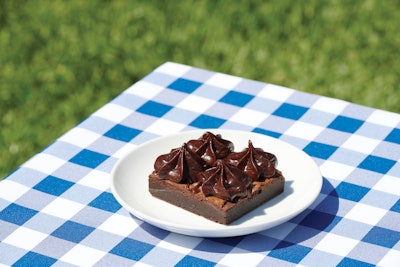 ReGrained baking mixes (used to make this brownie) are based on SuperGrain+ flour, made from brewers’ spent grain.Upcycled Foods Inc.
ReGrained baking mixes (used to make this brownie) are based on SuperGrain+ flour, made from brewers’ spent grain.Upcycled Foods Inc.
“We stumbled upon this term upcycled, which was mostly something that was used to talk about hard goods—things like water bottles being turned into sweatshirts,” Kurzrock recalls. “When we came up with the idea for turning the grain that’s been used to make beer into a food ingredient, we needed some language for how to talk about what we were doing. The term upcycling really struck a chord because it suggests quite clearly that it is about up-leveling something, creating something of higher value.”
From UFA’s perspective, the goal of upcycling is to create ingredients that are used for human consumption.
“About 80% of the grain in the U.S. from breweries goes to animal feed destinations—that is business as usual. Now, that’s better than it going to landfill, which does happen in parts of the world,” Kurzrock says. “There’s a history of this going back thousands of years—we’ve been making beer since the dawn of civilization. So that is not an upcycle. That’s actually a recycle more. It’s not a full downcycle to landfill, but it’s certainly not putting the full value of this raw material to its highest and best use, which is what upcycling is all about.”
New opportunities in upcycling
Distilleries have had many of the same opportunities as breweries to divert their waste streams to local farms as animal feed. Flottweg was working with a major distillery in Tennessee several years ago to help dry what had been thousands of gallons a day going out in a very liquid form. “We ran it through a centrifuge and it went out in 255-gal drums after that,” says Rob Rhea, general manager for Flottweg. “It was one of those things where farmers were more interested in taking this and adding it as a supplement because it still had a good nutrient value.”
But Rhea sees a new movement afoot, coming from the business that Flottweg does in ethanol plants, which are producing corn oil as a valuable byproduct of the process. He sees a similar opportunity for large distilleries. “Essentially, a distillery is an ethanol plant—it’s just that instead of creating ethanol, you’re creating a drinking alcohol,” he says. “Some of these distilleries are large enough now that they’re realizing how much money they’re letting go out in distiller’s dried grains. Now, some of the larger distilleries are moving toward corn oil production. That, to me, is another great opportunity to take what would have been waste, and they’re able to get a value for it.”
There is often going to be a divide between whether upcycling should be destined for human or animal consumption, says Flottweg’s Bill Griffiths, who points out that perhaps it doesn’t need to be for consumption at all (or ingestion, at least). “Anything we can do to keep something out of a landfill or out of a municipal wastewater process is a positive, and then at that point are we calling that material to its highest-value purpose? That’s the kicker,” he says.
Griffiths is in the edible fats and oils group at Flottweg, focused on dewatering waste streams from industrial food processors such as slaughter facilities. “Places that would aggregate grease trap waste or brown grease and try to purify and upcycle it so that it can be sold for its highest possible purpose at that point, which lately has been renewable diesel.”
For a long time, the main job of a wastewater employee at a slaughterhouse was to not get the facility fined by the Environmental Protection Agency (EPA) or local water municipality, Griffiths says. “But with fat prices going up, thanks in large part to the renewable diesel boom going on, now they’re being tasked with: ‘Don’t get us fined, but also get us all that oil.’”
In the past, the slaughterhouse would try to get those leftover fats into a solid phase so they could be sent to a landfill. It sat at room temperature to congeal and was likely contaminated by something that prevented taking it to a rendering company. The fat was typically scraped off the top layer in a dissolved air flotation (DAF) table to leave cleaner water at the bottom. Now, by using multiple DAF tables in succession, along with some chemical treatment and a centrifuge, processors are able to recover more of the oils. Another development is the use of a Tricanter on the skimmings from the first DAF table, which enables recovery of about 99% of the free oil that’s present, Griffiths says.
A vision to the future
“Every time beer is brewed, nutritious food is also created. But right now, that food is being put to the path of least resistance, which is typically animal feed, as opposed to the path of highest value, which is what we’re doing,” Kurzrock says. “We’re hoping to play a key role in rewriting how the global beer industry and food industries operate together as an ecosystem, as opposed to as separate silos.”
UFA tends to see more adoption of upcycled ingredients from smaller startups, but that’s starting to change, according to Brink. “The company type that is adopting an upcycling mindset is a lot of times smaller CPG brands and startups, spaces where there are a lot of people really thinking about how to innovate, how to get ahead, and people that are starting a business with upcycling already as part of their core business model,” she says. “But there are a lot of larger companies and brands that are getting excited about the possibilities of upcycling. And I think there’s a lot of crossover happening between them as well, which is really important because they all have different strengths.”





